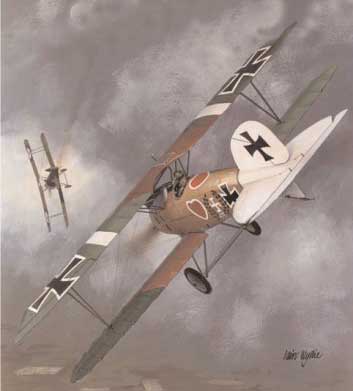|
The Albatros DIII came from the factory with a clear doped, fuselage made of plywood The fabric covered wings were camouflaged in german purple and dark green. The national markings were typically applied right over the the factory finish. Unlike the triplane, the markings were not applied over a large white rectangle. Instead the black maltese cross just received a white border.
The natural wood grain of the plywood would show through the clear dope. This means you would also see where the numerous pieces of plywood had been fitted together. It also means that patched bullet holes and weathering would also take its toll on the natural beauty of the wood. Like almost all planes in Jasta 2, the nose on Voß' plane was red. Voß had painted a red heart similar to a Valentine's Day candy box on each side of his fuselage. Later, a third heart was painted on the top of the fuselage.
Also on each side of the plane, a white swastika surrounded by a olive wreath has been painted. For years the swastika was considered a sign of good luck or fortune and examples could be found on aircraft from every nation during WWI. It was not until the rise of Nazi Germany that the swastika became a symbol of hatred and evil and fell from favor.
|

